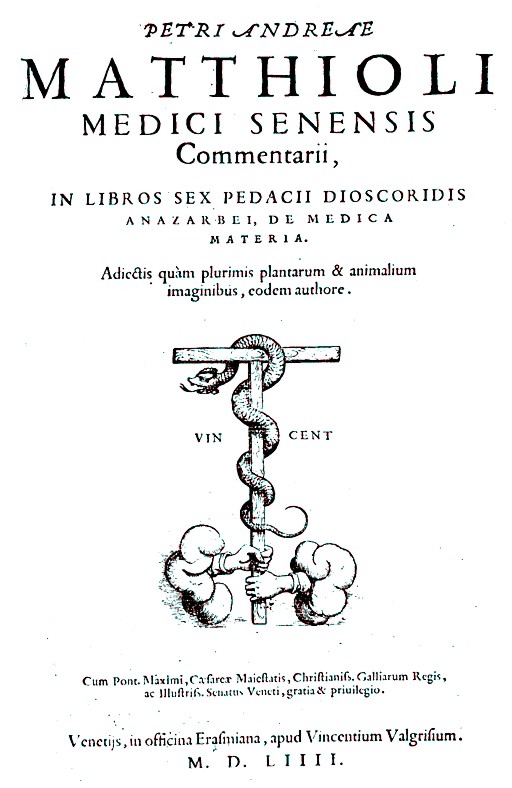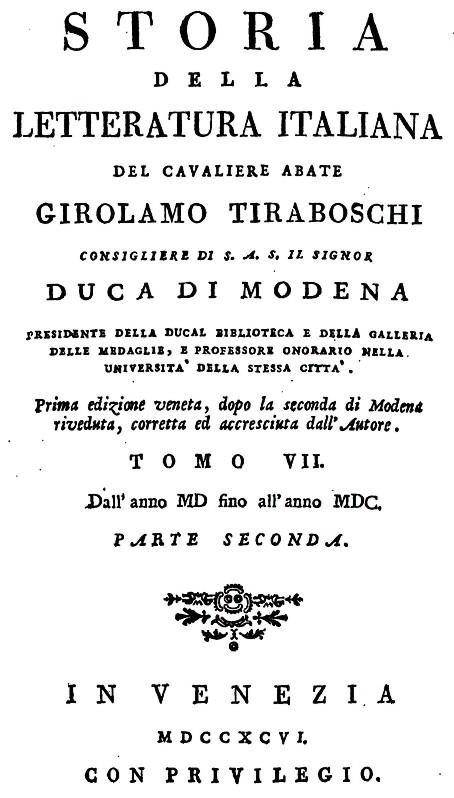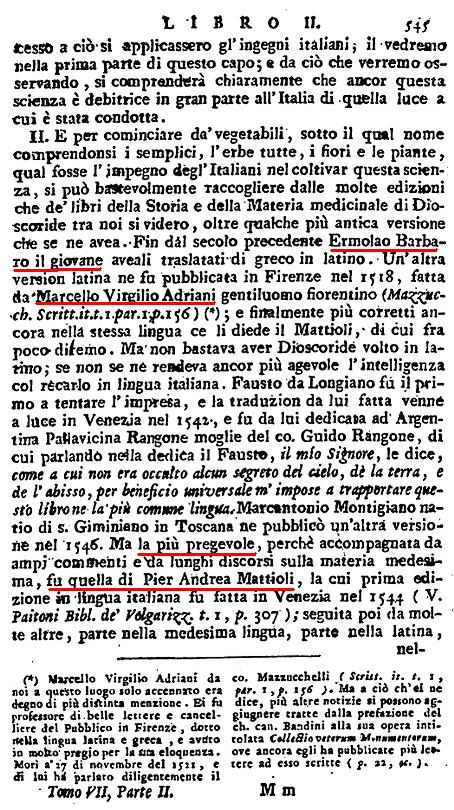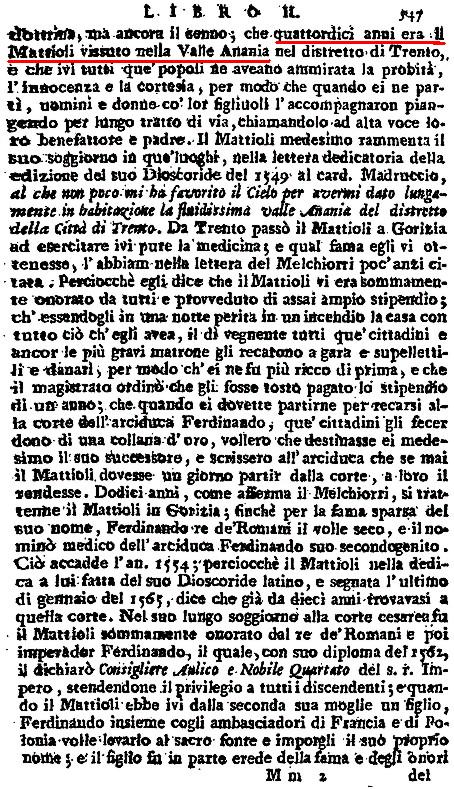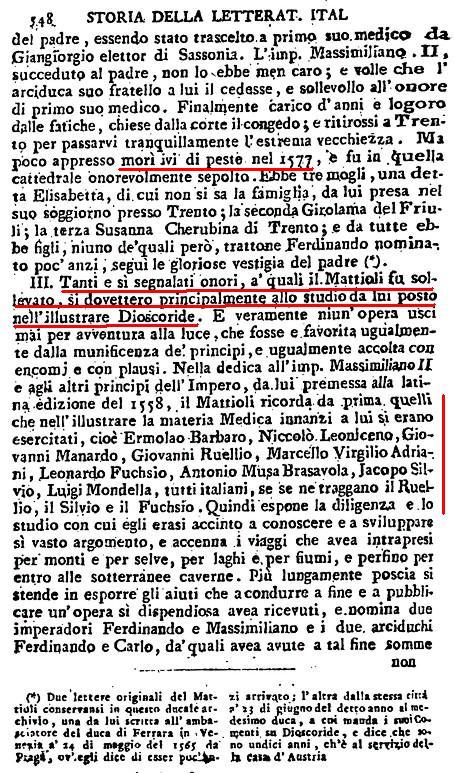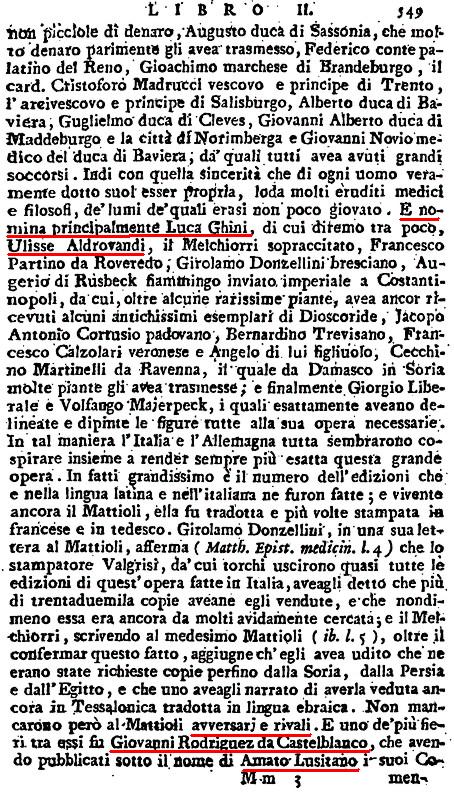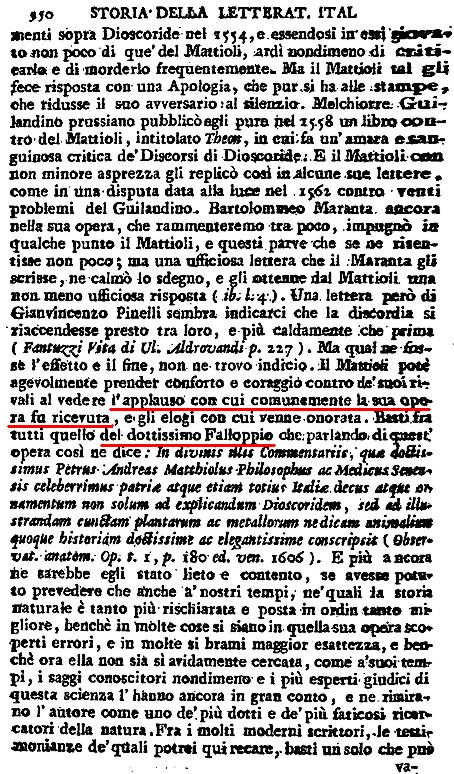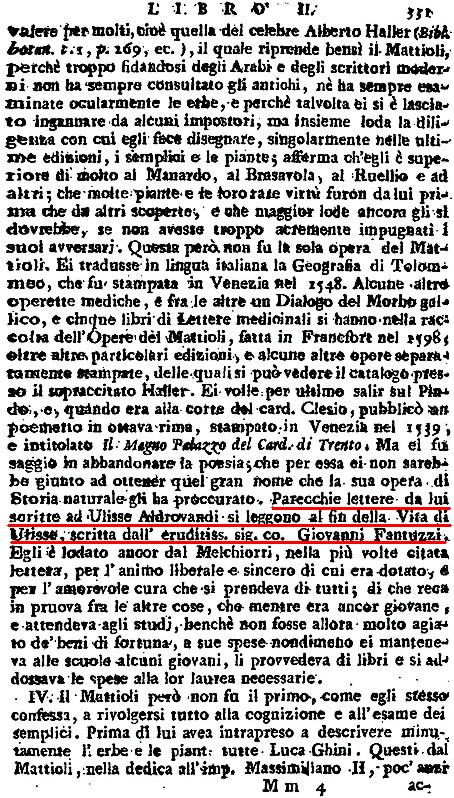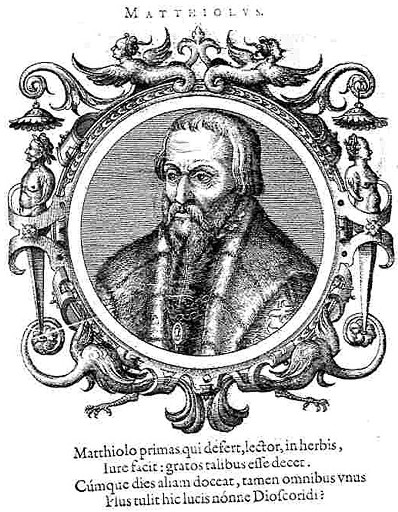Lessico
Pierandrea Mattioli
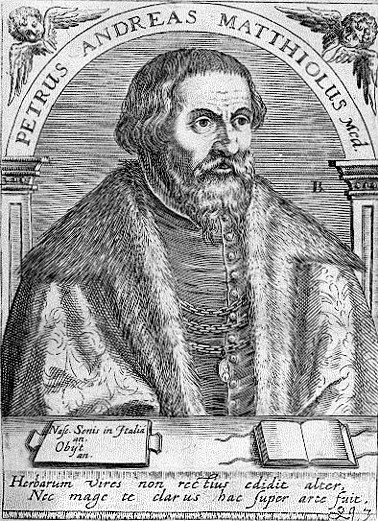
incisione
di Theodor de Bry (1528-1598)
da Bibliotheca chalcographica di Jean-Jacques Boissard - 1669
Naturalista e medico (Siena 1500 - Trento 1577). Altre fonti danno rispettivamente 1501 e 1578. Nasce a Siena nel 1500 da Francesco Mattioli, medico, e da Lucrezia Buoninsegna. Si trasferisce col padre a Venezia e nel 1523 si laurea a Padova in medicina. Rientrato a Siena alla morte del padre, se ne allontana poco dopo a causa degli scontri tra le diverse fazioni, per recarsi a Perugia che lascia, dopo la specializzazione in chirurgia, per raggiungere Roma dove si ferma fino al 1527, anno del sacco.
Nel 1527
si sposta a Trento, divenendo medico personale del Principe Vescovo Bernardo
di Clès![]() .
Al potente protettore dedica il trattato De morbo gallico e il poema in
versi Il Magno Palazzo del Cardinale di Trento, pubblicato nel 1539.
Quest’opera costituisce un documento di grande importanza, perché fornisce
preziose informazioni sul nuovo aspetto assunto dal Castello del Buonconsiglio
dopo gli interventi architettonici voluti da Bernardo di Clès. Mattioli si
trattiene in Trentino per circa un trentennio, durante il quale soggiorna
soprattutto in Val di Non (in provincia di Trento, detta anche Valle Anania
.
Al potente protettore dedica il trattato De morbo gallico e il poema in
versi Il Magno Palazzo del Cardinale di Trento, pubblicato nel 1539.
Quest’opera costituisce un documento di grande importanza, perché fornisce
preziose informazioni sul nuovo aspetto assunto dal Castello del Buonconsiglio
dopo gli interventi architettonici voluti da Bernardo di Clès. Mattioli si
trattiene in Trentino per circa un trentennio, durante il quale soggiorna
soprattutto in Val di Non (in provincia di Trento, detta anche Valle Anania![]() o
Anaunia), nei dintorni di Trento e sul monte Baldo.
o
Anaunia), nei dintorni di Trento e sul monte Baldo.
In queste zone di montagna ha modo di dedicarsi alla botanica, sua grande passione e di venire in contatto con conoscenze e tradizioni popolari che forniranno la base delle sue ricerche sulle proprietà terapeutiche delle piante.
Nel 1539,
forse a seguito della morte del Principe Vescovo Bernardo, parte alla volta di
Gorizia e, in seguito, di Praga. Nel 1544 pubblica a Venezia il suo lavoro di
botanica Discorsi redatto
in italiano e nel 1554 pubblica sempre a Venezia, ma in latino,
l’equivalente opera a carattere naturalistico e terapeutico che lo rese
celebre: Commentarii in libros sex Pedacii Dioscoridis Anazarbei De Medica
Materia![]() (Venetiis, apud Valgrisium, 1554) e che dominò il sapere botanico
per due secoli, con 61 edizioni e con traduzione in 5 lingue.
(Venetiis, apud Valgrisium, 1554) e che dominò il sapere botanico
per due secoli, con 61 edizioni e con traduzione in 5 lingue.
La prima
traduzione in italiano dei Commentarii vide anch’essa la luce a
Venezia nel 1557 ad opera di
Valgrisi. Pierandrea Mattioli raggiunge l’apice della sua carriera nel 1555,
quando Ferdinando I d’Austria![]() lo chiama a corte come medico personale del suo secondogenito e rimane a
servizio degli Asburgo (anche di Massimiliano II
lo chiama a corte come medico personale del suo secondogenito e rimane a
servizio degli Asburgo (anche di Massimiliano II![]() ,
primogenito di Ferdinando I e suo successore nel 1564)
fino al 1571, anno in cui decide di far ritorno a Trento, dove rimane
fino alla morte nel 1577 dovuta alla peste
,
primogenito di Ferdinando I e suo successore nel 1564)
fino al 1571, anno in cui decide di far ritorno a Trento, dove rimane
fino alla morte nel 1577 dovuta alla peste![]() e
viene sepolto nella cattedrale di San Vigilio
e
viene sepolto nella cattedrale di San Vigilio![]() , dove gli viene eretto
un sepolcro marmoreo che lo raffigura al suo tavolo da lavoro.
, dove gli viene eretto
un sepolcro marmoreo che lo raffigura al suo tavolo da lavoro.
Per i suoi meriti Charles Plumier![]() , valoroso botanico di Marsiglia
(1646-1706), gli dedicò il genere Matthiola
, valoroso botanico di Marsiglia
(1646-1706), gli dedicò il genere Matthiola![]() . La sua pietra tombale è conservata all’ingresso
del Duomo di Trento.
. La sua pietra tombale è conservata all’ingresso
del Duomo di Trento.
da www.buoncosiglio.it - con alcune modifiche e aggiunte
Pietro Andrea Mattioli
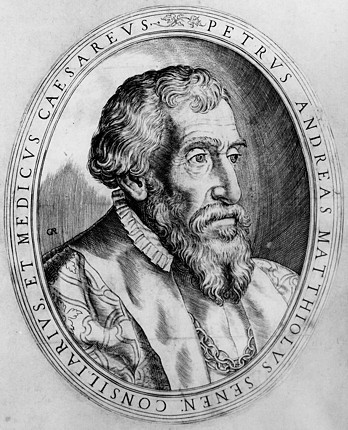
Pietro
Andrea Mattioli (Siena, 12 marzo 1501 – Trento, 1578) è stato un umanista e
medico italiano. Pietro (Pier) Andrea Mattioli (Matthioli) nasce a Siena nel
1501 (1500 ab incarnatione![]() ), ma
passa la sua infanzia a Venezia, dove il padre, Francesco, esercita la
professione di medico. Appena sufficientemente grande, il padre lo manda a
Padova dove inizia a studiare varie materie, tipiche dell'epoca, come il
latino, il greco antico, la retorica e la filosofia. Tuttavia Pietro Andrea si
appassiona più che a tutte alla medicina, e proprio in questa materia si
laurea nel 1523. Quando il padre muore, torna tuttavia a Siena ma la città è
sconvolta da una faida tra famiglie rivali per cui decide di recarsi a Perugia
per studiare chirurgia sotto il maestro Gregorio Caravita.
), ma
passa la sua infanzia a Venezia, dove il padre, Francesco, esercita la
professione di medico. Appena sufficientemente grande, il padre lo manda a
Padova dove inizia a studiare varie materie, tipiche dell'epoca, come il
latino, il greco antico, la retorica e la filosofia. Tuttavia Pietro Andrea si
appassiona più che a tutte alla medicina, e proprio in questa materia si
laurea nel 1523. Quando il padre muore, torna tuttavia a Siena ma la città è
sconvolta da una faida tra famiglie rivali per cui decide di recarsi a Perugia
per studiare chirurgia sotto il maestro Gregorio Caravita.
Da lì si
trasferisce a Roma dove continua i suoi studi medici presso l' Ospedale di
Santo Spirito e lo Xenodochium San Giacomo per gli incurabili, ma nel 1527, a
causa del sacco dei Lanzichenecchi, decide di lasciare la città per
trasferirsi a Trento dove rimane per un trentennio. Va quindi a vivere in Val
di Non e presto la sua fama giunge alle orecchie del principe-vescovo Bernardo
Clesio![]() che lo
invita presso il castello del Buonconsiglio offrendogli il posto di
consigliere e medico personale. Proprio al vescovo Clesio, Mattioli dedicherà
due delle sue prime opere, una delle quali, il poema in versi «Il Magno
Palazzo del Cardinale di Trento», descrive in dettaglio la ristrutturazione
di carattere rinascimentale che il vescovo ordinò per il suo castello. Il
poema, pubblicato nel 1539 dal Marcolini a Venezia, utilizza una struttura
detta dell'ottava rima, come quella che usava il Boccaccio
che lo
invita presso il castello del Buonconsiglio offrendogli il posto di
consigliere e medico personale. Proprio al vescovo Clesio, Mattioli dedicherà
due delle sue prime opere, una delle quali, il poema in versi «Il Magno
Palazzo del Cardinale di Trento», descrive in dettaglio la ristrutturazione
di carattere rinascimentale che il vescovo ordinò per il suo castello. Il
poema, pubblicato nel 1539 dal Marcolini a Venezia, utilizza una struttura
detta dell'ottava rima, come quella che usava il Boccaccio![]() , ma non
è opera dello stesso livello di quelle di altri poeti dell'epoca.
, ma non
è opera dello stesso livello di quelle di altri poeti dell'epoca.
Nel 1528
Mattioli sposa una donna trentina, una tal Elisabetta di cui non è noto il
cognome, e dalla quale ha un figlio. Cinque anni dopo pubblica il suo primo
libello: «Morbi Gallici Novum ac Utilissimum Opusculum» e inizia a lavorare
alla sua opera su Dioscoride![]() . Poi nel
1536 Mattioli accompagna Bernardo Clesio a Napoli per un incontro con
l'imperatore Carlo V. Quando tuttavia Bernardo Clesio muore, nel 1539, gli
succede Cristoforo Madruzzo il quale ha già un medico, e così Mattioli si
trasferisce a Cles, dove tuttavia si trova presto in ristrettezze finanziarie.
. Poi nel
1536 Mattioli accompagna Bernardo Clesio a Napoli per un incontro con
l'imperatore Carlo V. Quando tuttavia Bernardo Clesio muore, nel 1539, gli
succede Cristoforo Madruzzo il quale ha già un medico, e così Mattioli si
trasferisce a Cles, dove tuttavia si trova presto in ristrettezze finanziarie.
Tra il 1541 e il 1542 Mattioli si trasferisce a Gorizia, dove pratica la professione di medico e lavora alla traduzione della Materia Medica di Dioscoride dal greco, aggiungendovi i suoi discorsi e commenti. Poi finalmente nel 1544 pubblica per la prima volta la sua opera principale, «Di Pedacio Dioscoride Anazarbeo Libri cinque Della historia, et materia medicinale tradotti in lingua volgare italiana da M. Pietro Andrea Matthiolo Sanese Medico, con amplissimi discorsi, et comenti, et dottissime annotationi, et censure del medesimo interprete», più comunemente conosciuto come i «Discorsi di Pier Andrea Mattioli» sull'opera di Dioscoride. La prima stesura fu pubblicata a Venezia senza le figure e fu dedicata al cardinale Cristoforo Madruzzo, principe-vescovo di Trento e Bressanone.
Da notare che Mattioli non si limita a tradurre l'opera di Dioscoride, ma la completa con i risultati di una serie di ricerche su piante ancora sconosciute all'epoca, trasformando i Discorsi in un'opera fondamentale sulle piante medicinali, un vero punto di riferimento per scienziati e medici per diversi secoli.
Nel 1548
pubblica la seconda edizione dei «Discorsi di Mattioli su Dioscoride», con
l'aggiunta del sesto libro sui rimedi contro i veleni, considerato apocrifo da
molti. In seguito vengono pubblicate molte altre edizioni, alcune tuttavia
senza la sua approvazione. Riceve anche molte critiche da notabili dell'epoca.
Nel 1554 viene pubblicata la prima edizione latina dei Discorsi di
Mattioli, chiamata anche Commentarii, ovvero «Petri Andreae Matthioli
Medici Senensis Commentarii, in Libros sex Pedacii Dioscoridis Anazarbei, de
Materia Medica, Adjectis quàm plurimis plantarum & animalium imaginibus,
eodem authore»![]() . È la
prima edizione a essere illustrata ed è dedicata a Ferdinando I d'Austria
. È la
prima edizione a essere illustrata ed è dedicata a Ferdinando I d'Austria![]() ,
allora Principe dei Romani, di Pannonia e di Boemia, infante di Spagna,
arciduca d'Austra, duca di Borgogna, conte e signore del Tirolo. In seguito
sarà tradotta anche in ceco (1562), tedesco (1563) e Francese.
,
allora Principe dei Romani, di Pannonia e di Boemia, infante di Spagna,
arciduca d'Austra, duca di Borgogna, conte e signore del Tirolo. In seguito
sarà tradotta anche in ceco (1562), tedesco (1563) e Francese.
In seguito a tanta fama e successo, Ferdinando I chiama Mattioli a Praga come medico personale del suo secondogenito arciduca Ferdinando. Prima di partire, tuttavia, gli abitanti di Gorizia decidono di donagli una preziosa catena d'oro che si può vedere in molte delle sue raffigurazioni, come segno di stima e affetto. Nonostante questo, nel 1555 Mattioli si trasferisce a Praga, anche se già l'anno successivo è costretto a seguire, suo malgrado, l'arciduca Ferdinando in Ungheria nella guerra contro i Turchi.
Nel 1557
si sposa per la seconda volta con una nobile goriziana, Girolama di Varmo
dalla quale ha due figli, Ferdinando nel 1562 e Massimiliano nel 1568, i cui
nomi sono scelti chiaramente in onore della casa reale. Proprio il 13 luglio
1562 Mattioli viene nominato da Ferdinando Consigliere Aulico e nobile del
Sacro Romano Impero. Quando Ferdinando muore nel 1564 sale al trono
Massimiliano II![]() . Per un po' Mattioli resta al servizio del nuovo sovrano, ma
nel 1571 decide di ritirarsi definitivamente a Trento. Due anni prima si era
sposato per la terza volta, di nuovo con una donna trentina, una tale Susanna
Caerubina.
. Per un po' Mattioli resta al servizio del nuovo sovrano, ma
nel 1571 decide di ritirarsi definitivamente a Trento. Due anni prima si era
sposato per la terza volta, di nuovo con una donna trentina, una tale Susanna
Caerubina.
Nel 1578
(1577 ab incarnatione) Pietro Andrea Mattioli muore di peste![]() a Trento
nel mese di gennaio o di febbraio. I figli Ferdinando e Massimiliano gli
dedicano un magnifico monumento funebre che pongono nel Duomo della città,
tuttora esistente.
a Trento
nel mese di gennaio o di febbraio. I figli Ferdinando e Massimiliano gli
dedicano un magnifico monumento funebre che pongono nel Duomo della città,
tuttora esistente.
Opere
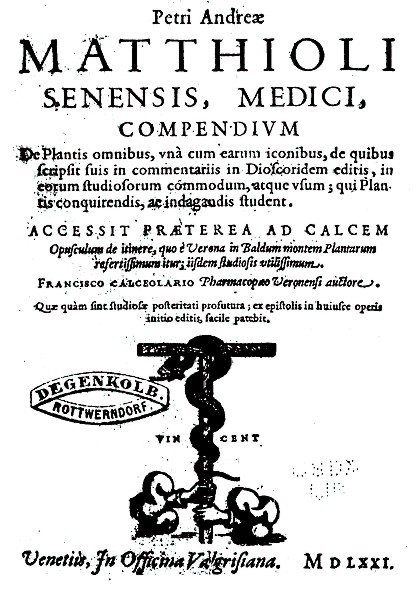
1533,
Morbi Gallici Novum ac Utilissimum Opusculum
1535, Liber de Morbo Gallico, dedicato a Bernardo Clesio
1536, De Morbi Gallici Curandi Ratione
1539, Il Magno Palazzo del Cardinale di Trento
1544, Di Pedacio Dioscoride Anazarbeo Libri cinque Della historia, et materia
medicinale tradotti in lingua volgare italiana da M. Pietro Andrea Matthiolo
Sanese Medico, con amplissimi discorsi, et comenti, et dottissime annotationi,
et censure del medesimo interprete, detti Discorsi
1548, Traduzione in italiano della Geografia di Tolomeo
1554, Petri Andreae Matthioli Medici Senensis Commentarii, in Libros sex
Pedacii Dioscoridis Anazarbei, de Materia Medica, Adjectis quàm plurimis
plantarum & animalium imaginibus, eodem authore, detti Commentarii
1558, Apologia Adversus Amatum Lusitanum![]()
1561, Epistolarum Medicinalium Libri Quinque
1569, Opusculum de Simplicium Medicamentorum Facultatibus
1571, Compendium de Plantis Omnibus una cum Earum Iconibus
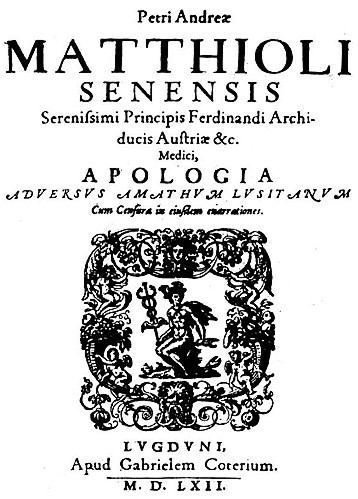
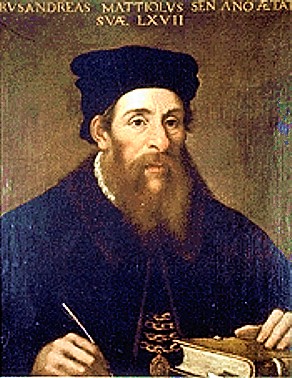
A
quell'epoca, nel Senese e nel Fiorentino, si utilizzava un calendario diverso
da quello usato attualmente e che inizia con il primo di gennaio. Quello
senese e fiorentino, infatti, iniziava il 25 marzo, ovvero il giorno
dell'Annunciazione a Maria. Tutte le date erano quindi un anno indietro tra il
1º gennaio e il 24 marzo. Questo modo di contare gli anni si chiamava "ab
incarnatione" e poiché Mattioli nacque e morì proprio nei primi mesi
dell'anno, ne derivano due date diverse sia per la sua data di nascita che per
quella di morte, a seconda del calendario considerato. Mentre infatti per il
calendario gregoriano il 1501 va dal gennaio 1501 al dicembre 1501, per quello
senese e fiorentino i primi tre mesi dell'anno, ovvero dal primo gennaio al 24
marzo, si è ancora nel 1500. Bisogna quindi fare attenzione allo stile delle
date per quanto riguarda la biografia di Mattioli come quella di altri
personaggi dello stesso periodo, anche perché papa Gregorio XIII![]() riformò il
calendario nel 1582 saltando 10 giorni in ottobre ma i domini fiorentini si
allinearono al nuovo calendario solo a partire dal 1750.
riformò il
calendario nel 1582 saltando 10 giorni in ottobre ma i domini fiorentini si
allinearono al nuovo calendario solo a partire dal 1750.
Valle
Anania
Valle Anaunia - Val di Non
Pierandrea
Mattioli a proposito dell'agarico![]() usa l'aggettivo latino Ananiensis per indicare i monti della Val di
Non: ipse quidem saepius in Ananiensibus montibus praestantissimum agaricum
parva quadam securi a laricibus quam pluribus deieci. Nella biografia di
Mattioli stilata da Girolamo Tiraboschi (Storia della letteratura italiana
1796) leggiamo che "quattordici anni era il Mattioli vissuto nella Valle
Anania nel distretto di Trento"
usa l'aggettivo latino Ananiensis per indicare i monti della Val di
Non: ipse quidem saepius in Ananiensibus montibus praestantissimum agaricum
parva quadam securi a laricibus quam pluribus deieci. Nella biografia di
Mattioli stilata da Girolamo Tiraboschi (Storia della letteratura italiana
1796) leggiamo che "quattordici anni era il Mattioli vissuto nella Valle
Anania nel distretto di Trento"![]() .
Oggi Anania è irreperibile sia nelle enciclopedie che nel web. Al suo posto
troviamo Anaunia. Anaunia deriva dal nome dell’antico capoluogo Anagnia,
oggi Sanzeno, 39 km a nord di Trento.
.
Oggi Anania è irreperibile sia nelle enciclopedie che nel web. Al suo posto
troviamo Anaunia. Anaunia deriva dal nome dell’antico capoluogo Anagnia,
oggi Sanzeno, 39 km a nord di Trento.
Anaunia regio imperii Romani in Alpibus erat. Haec regio habebat duas valles quae recentibus temporibus sermo Italianus Val di Non et Val di Sole, Germanicus autem Nonstal sive Nonsberg et Sulzberg appellat. – web
Val di Non
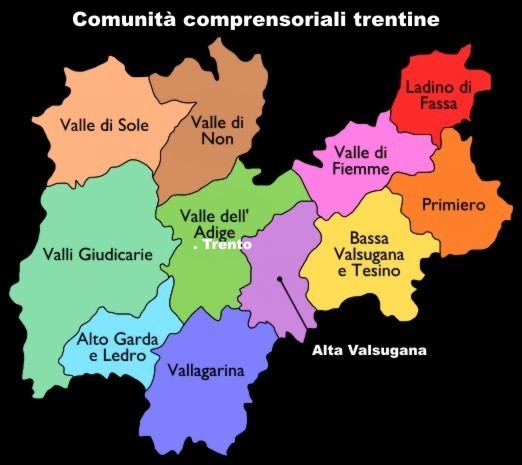
La Val di Non è una delle principali valli del Trentino, situata nella parte nord-occidentale della provincia. È costituita da un ampio altopiano, attraversato dal torrente Noce e conta 38 comuni. Orograficamente la valle si biforca a Y all'altezza del lago di Santa Giustina e quindi la zona si divide in sponda destra (a ovest del Noce), sponda sinistra (d est del fiume) e "terza sponda" (la zona a nord del Noce e del rio Novella).
La Val di Non ha 38 comuni
1 Castelfondo - 2 Fondo - 3 Malosco - 4 Brez - 5 Sarnonico - 6 Ronzone - 7 Ruffrè-Mendola - 8 Cavareno - 9 Amblar - 10 Romeno - 11 Don - 12 Rumo - 13 Bresimo - 14 Cis – 15 Livo - 16 Cagnò - 17 Revò - 18 Romallo - 19 Dambel - 20 Cloz - 21 Sanzeno - 22 Cles - 23 Coredo - 24 Smarano - 25 Sfruz - 26 Vervò - 27 Tassullo - 28 Tuenno - 29 Terres - 30 Nanno – 31 Taio - 32 Tres - 33 Ton - 34 Sporminore - 35 Denno - 36 Cunevo - 37 Flavon - 38 Campodenno
La valle si apre a occidente della Valle dell'Adige, all'altezza della confluenza del Noce nell'Adige. Deve il suo nome ai Monti Anauni che la separano dalla Bassa Atesina e dalla Val d'Adige. In tempi remoti era infatti chiamata Valle Anaune e nel corso dei secoli mutò il suo nome in Val di Non grazie alla lingua dialettale dei suoi abitanti, il Nones, secondo alcuni linguisti di derivazione ladina. A occidente è delimitata dalle Dolomiti di Brenta, mentre a nord-ovest, dove nasce la Val di Sole, dalla Catena delle Maddalene; confina infine a settentrione con la Val d'Ultimo e l'Alto Adige.
La valle è raggiungibile, oltre che dall'accesso principale costituto dalla strada statale 43 che la collega con Mezzolombardo e la Valle dell'Adige attraverso la Forra della Rocchetta, da altri 3 passi: il Passo Palade da Merano, il Passo della Mendola da Caldaro e Bolzano, infine il Ponte di Mostizzolo che la collega a est con la Val di Sole, da cui per il Passo del Tonale si passa in Lombardia. È inoltre attraversata dalla Ferrovia Trento-Malè.
Il centro
abitato più importante della vallata è Cles, che sorge a lato del grande
lago artificiale di Santa Giustina. La valle è ricca di storia, dal tempo
degli antichi romani che avevano intuito l'importanza di questi territori
vicini al Passo del Brennero, fino al Medioevo, periodo in cui sorgono
numerosi castelli, come Castel Thun, Castel Bragher, Castel Coredo, Castel
Cles oppure come il Santuario di San Romedio![]() ,
o i palazzi assessorili di Cles e Coredo, che divennero i centri
giuridico-amministrativi più importanti del periodo, in cui sono state emesse
anche sentenze di condanna a morte nel periodo di caccia alle streghe. In
valle sono presenti numerosi laghi, come il lago artificiale di Santa Giustina
e i laghi di Coredo e Tavon e di Tovel, segno dell'abbondanza di acqua della
zona.
,
o i palazzi assessorili di Cles e Coredo, che divennero i centri
giuridico-amministrativi più importanti del periodo, in cui sono state emesse
anche sentenze di condanna a morte nel periodo di caccia alle streghe. In
valle sono presenti numerosi laghi, come il lago artificiale di Santa Giustina
e i laghi di Coredo e Tavon e di Tovel, segno dell'abbondanza di acqua della
zona.
L'economia della vallata è principalmente di tipo agricolo (frutticolo): la valle è resa famosa dalla vastissima produzione delle mele Golden conosciute commercialmente con il marchio Melinda (primo marchio DOP concesso per un prodotto del settore frutticolo). Ricoprono una discreta importanza per l'economia locale anche il turismo e l'artigianato, sono inoltre presenti alcune aree artigianali e con piccole industrie e cementifici nella zona di Cles, Tassullo e Mollaro. Nell'alta valle di Non sono anche presenti piccole imprese legate all'industria del legno che producono imballaggi.
Percorsi d'Anaunia
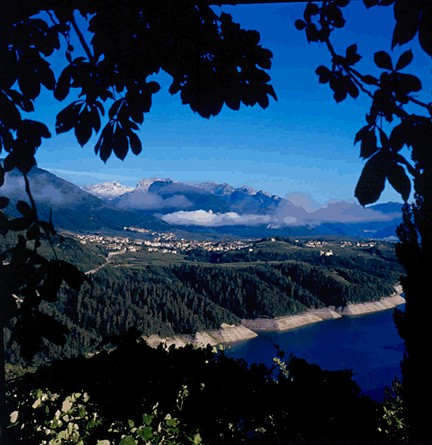
La particolare configurazione del territorio della Valle di Non, con ampi terrazzi morenici incisi dalle profonde forre dei Torrenti Noce e Novella, distingue - da un punto di vista geomorfologico - tre distinte zone localmente definite come sponda sinistra, sponda destra e terza sponda: quella in sinistra orografica del Torrente Noce, dalla gola della Rocchetta a sud, fino al Passo delle Palade a nord, comprendente l’ampio territorio dominato dalla lunga e boscosa catena del Monte Roen è storicamente individuata come Anaunia dal nome dell’antico capoluogo Anagnia (Sanzeno); tale zona è citata nell’importante documento storico risalente al 46 dC rinvenuto a Cles (Tavola Clesiana), con il quale l’imperatore Claudio concedeva la cittadinanza romana agli abitanti della valle, distinguendoli in Anauni, Tuliassi e Sinduni, probabilmente in funzione della loro collocazione geografica.
L’Anaunia
è a sua volta divisa dalla profonda forra del Torrente San Romedio che ne
delimita la parte nord (Alta Anaunia o, in gergo popolare locale, “Soratovo”).
Beneficiando della notevole ricchezza di beni storici (castelli, torri,
viabilità antica etc.) e ambientali (forre, grotte, punti panoramici,
vegetazione etc.), presenti in questo ambito geografico, sono stati ideati e
proposti i seguenti 12 percorsi di tipo turistico-escursionistico, finalizzati
al collegamento e alla riscoperta di tali luoghi. L’asse principale di
collegamento, dalla Rocchetta a San Romedio![]() ,
costituito dai percorsi n. 1-4-5-6-8-12 si sviluppa per circa 20 km, partendo
dai ruderi della Torre di Visione (castello medioevale con amplissimo
panorama) sovrastante la gola della Rocchetta, arrivando fino alla pineta
oltre l’abitato di Smarano a ridosso della Valle del Verdès in fondo alla
quale sorge il famoso santuario, raggiungibile tramite sentiero che,
dipartendosi dal percorso n. 12, scende al lago di Tavon e successivamente a
San Romedio.
,
costituito dai percorsi n. 1-4-5-6-8-12 si sviluppa per circa 20 km, partendo
dai ruderi della Torre di Visione (castello medioevale con amplissimo
panorama) sovrastante la gola della Rocchetta, arrivando fino alla pineta
oltre l’abitato di Smarano a ridosso della Valle del Verdès in fondo alla
quale sorge il famoso santuario, raggiungibile tramite sentiero che,
dipartendosi dal percorso n. 12, scende al lago di Tavon e successivamente a
San Romedio.
Tale sistema di percorsi recupera la viabilità antica che dalla Rocchetta giunge a Castel Thun e in seguito al notevole complesso edilizio - religioso di San Martino a Vervò, attraverso bei boschi di faggio e conifere, passando per la guarnigione di Prà Ciastel (ruderi, probabile luogo di sosta e cambio dei cavalli), Mas del Mont (ampia e panoramica distesa prativa) e attraversando la forra del Rio Pongaiola; successivamente il percorso prosegue a monte dell’abitato di Vervò riprendendo comode strade forestali, fino agli abitati di Sfruz e Smarano, dopo aver attraversato la valletta del rio di Sette Fontane. Anche quest’ ultimo tratto di percorso rappresenta probabilmente l’antica viabilità di collegamento fra gli abitati di Vervò e Tres con Smarano e Sfruz, separati dal solco vallivo del rio Sette Fontane.
Dall’itinerario principale si dipartono dei tracciati (per altri 25 km complessivi, finalizzati al raggiungimento di manufatti e luoghi di particolare interesse: in prossimità di Vigo d’Anaunia, tramite i percorsi n. 2 e 3, rispettivamente il castel S.Pietro (XII sec. su sperone roccioso lungo l’antica via che collegava la Val d’Adige) e la forra della Val Ciucina; a valle di Priò, l’agevole e lungo percorso n. 7, da Priò a Castel Bragher (XIII sec.), transitando per l’abitato di Vion; a Tres, i percorsi n. 9 e 10 passando per il “Lac del Bosc” (bella conca prativa con biotopo lacustre) o raggiungere il singolare anfratto roccioso “Vout Sette Fontane”, con possibilità di proseguire per Sfruz o Smarano; da questi, il sistema di percorsi è collegato verso monte con il panoramico altopiano della Predaia (percorsi n. 8 e 11) e - tramite la strada esistente che sale all’omonimo rifugio, con la sentieristica CAI che corre in quota lungo la dorsale della Catena del Monte Roen (Sentiero Italia), raggiungibile anche dal versante atesino (Mezzocorona, Favogna e Termeno).
www.percorsianaunia.it
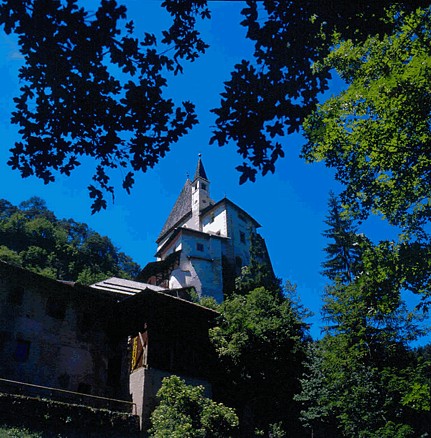
Scrigno di spiritualità e suggestione
Attraverso una passeggiata panoramica lungo fitti boschi e anfratti rocciosi, sospesi sopra le acque che scorrono nel fondo valle, si giunge alla splendida cornice del Santuario di San Romedio. Una ripida scalinata di 131 gradini conduce il visitatore, attraverso un complesso di piccolissime chiesette sovrapposte, sulla sommità dello scoglio roccioso, alto più di settanta metri, dove, secondo la leggenda, si sarebbe rifugiato in eremitaggio San Romedio.
Si narra di come, sul finire del X secolo, il nobile Romedio, erede della prestigiosa casata tirolese dei Thaur, chiamato dalla voce di Dio, abbandonate tutte le sue ricchezze, decise di cercare la vera felicità e la comunione col Creatore ritirandosi in meditazione sulla cima di una roccia. Alla sua morte, coloro che gli erano stati fedeli, scavarono nella roccia la sua tomba e diedero vita al culto che dal lontano anno 1000 si perpetua ancor oggi.
A partire dalla prima cappella costruita nell'XI secolo, la fede degli umili nel loro Santo protettore fece sì che venissero erette, nel corso dei secoli, una sopra le altre, tre piccole chiesette, due cappelle e sette edicole della Passione, vere custodi della sacralità e della magia del santuario. La fede nel Santo in Valle era davvero forte, tanto che a partire dal XV secolo le pareti lungo la scalinata che conduce alla tomba dell'eremita si riempirono di oggetti ex-voto, segni dell'immensa fiducia dei pellegrini nel potere del Santo.
Il Santuario di San Romedio, uno dei più suggestivi in Europa, spesso ricordato anche per l'area faunistica adiacente l'ingresso in cui vivono in semilibertà due orsi, vera mascotte di tutti i bambini della Val di Non. La loro presenza in questo luogo di culto è¨ legata alla leggenda secondo cui Romedio, ormai vecchio, si sarebbe incamminato verso la città deciso a incontrare il Vescovo di Trento Vigilio. Lungo il percorso il suo cavallo sarebbe stato sbranato da un orso, Romedio tuttavia non si diede per vinto e avvicinatosi alla bestia sarebbe riuscito miracolosamente a renderla mansueta e a cavalcarla fino a Trento. Il 15 gennaio di ogni anno si festeggia il giorno di San Romedio con una messa e il tradizionale piatto del pellegrino a base di trippe.
www.valledinon.tn.it
Sulle orme di Pierandrea Mattioli
un piovoso 12 agosto 2006
foto
di Claudia Mattioli e Simone Savastano![]()
Nel
centro della città, in piazza del Duomo, sorge la cattedrale di San Vigilio![]() ,
costruzione romanico-gotica di derivazione lombarda dei secoli XII-XIV, con
aggiunte successive. Vi si tennero tutte le sedute formali del Concilio
Tridentino, dal dicembre 1545 al dicembre 1563.
,
costruzione romanico-gotica di derivazione lombarda dei secoli XII-XIV, con
aggiunte successive. Vi si tennero tutte le sedute formali del Concilio
Tridentino, dal dicembre 1545 al dicembre 1563.
Pierandrea Mattioli sta stilando il suo commento a Dioscoride
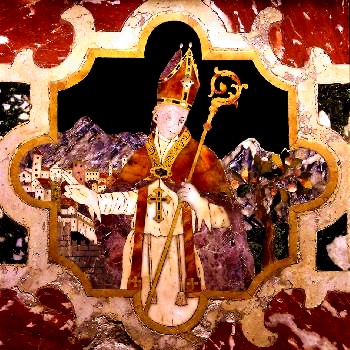
Vescovo e patrono della città di Trento, visse nella seconda metà del IV secolo. Le notizie che abbiamo mescolano dati storicamente documentati ad altri di origine leggendaria, come probabilmente il martirio, avvenuto secondo la tradizione a opera delle popolazioni pagane trentine della Val Rendena. Recatosi in quelle zone con l’intento di convertirle, il vescovo Vigilio vi avrebbe trovato la morte per lapidazione. Una diffusa iconografia popolare, affermatasi in tempi più tardivi, rappresenta il santo con accanto uno zoccolo, ritenuto strumento del suo martirio.
Dalla corrispondenza epistolare giunta fino a noi fra San Vigilio e
Sant'Ambrogio vescovo di Milano![]() ,
sappiamo che fu quest'ultimo a inviare in Trentino Sisinio, Martirio e Alessandro per coadiuvare il vescovo Vigilio nella sua attività
pastorale.
,
sappiamo che fu quest'ultimo a inviare in Trentino Sisinio, Martirio e Alessandro per coadiuvare il vescovo Vigilio nella sua attività
pastorale.
Bernardo di Clès
Bernardo
Clesio
Umanista italiano (Clès 1485 - Bressanone 1539). Vescovo-principe di Trento (1514), cardinale nel 1530, fu consigliere di Carlo V e avversò la Riforma protestante. Mecenate, fu in rapporti di amicizia con Erasmo da Rotterdam e con Pietro Bembo.
Ferdinando I d'Asburgo
Imperatore (Alcalá de Henares 1503 - Vienna 1564). Fratello minore dell'imperatore Carlo V, che nel 1521 gli cedette le terre ereditarie asburgiche (in cambio della rinuncia allo smembramento dei Paesi Bassi) e, nel 1531, il titolo di re dei Romani. Dopo una lunga collaborazione col fratello, in seguito all'abdicazione di Carlo ebbe nel 1558 il titolo imperiale. Educato in Spagna dal nonno Ferdinando II il Cattolico, sposò (1521) Anna Iagellona e pose la sua candidatura al trono di Ungheria e di Boemia che ebbe, almeno formalmente, alla morte del cognato, re Luigi II (1526). Pur lottando contro la diffusione della Riforma, si adoperò sin dal 1531 per una soluzione pacifica, elaborando, anche per conto di Carlo V, la Pace di Augusta (1555). Pazienza e tempismo politico gli permisero di consolidare il potere nell'Est: concesse alcune libertà all'Ungheria stremata dopo la sconfitta subita dai Turchi a Mohács (1526). Con i Turchi stipulò nel 1547 un patto; in Boemia sottomise gli avversari dopo la guerra di Smalcalda (1547), ma usò una prudente tolleranza religiosa. Con gli ordinamenti del 1527 varò una decisiva riforma amministrativa, che diede l'avvio alla trasformazione dell'Austria in Stato moderno, centralizzato ed efficiente.
Massimiliano II d'Asburgo
Imperatore (Vienna 1527 - Ratisbona 1576). Primogenito di Ferdinando I, gli succedette nel 1564 (dopo essere già stato eletto re di Boemia e di Germania, 1562, e re d'Ungheria, 1563), garantendo formalmente la continuità del cattolicesimo in Germania, nonostante le sue inclinazioni luterane. Per mantenere l'unità della casata sposò (1548) la cugina Maria, figlia di Carlo V, e concedette la figlia Anna in moglie a Filippo II (1570). In Austria e Ungheria tollerò le conversioni al luteranesimo di molti nobili, pur rafforzando la Chiesa cattolica; verso i Turchi adottò una politica di pace. Eletto re di Polonia nel 1575 in concorrenza con Stefano Bathory, morì improvvisamente l'anno successivo dopo aver assicurato la successione al figlio Rodolfo.
|
Matthioli www.alessandrina.librari.beniculturali.it
Icones veterum aliquot ac recentium Medicorum
Philosophorumque Matthioli’s Commentary on Dioscorides
is one of the great books of the Renaissance. It had a major influence
on medicine and botany around Europe, being bought and, one presumes,
consulted by scholars from Cambridge to Cracow[1]. In its importance in its subject, it
can be compared with Vesalius’ Fabrica in anatomy, or with
Fracastoro’s ideas on contagious diseases[2]. As an object of beauty it graces the
display cabinets of many libraries, and it may still be studied with
profit for the botanical and historical information it contains. Yet
how and why Matthioli and his book came to occupy this position of
preeminence are questions that have not been adequately examined, for
there is always a tendency to assume that the reasons for the success
of any literary work are almost self-evident: it was a great success,
therefore it must have been a brilliant book. But, as we know,
brilliant books may meet with commercial and academic failure; and
best-sellers may not be the most deserving of that honour. Why was it
that Matthioli’s book and not that of, say, Fuchs It should be stated at the outset that
any answer must take account of chronology: it is not only that the
book itself changed as it went through various editions and
translations, generally becoming larger with additional material, but
Matthioli’s own career and circumstances changed. The doctor at
Trento and Gorizia in the 1530’s and 1540’s was not the
international figure that he became in the 1550’s; the provincial
physician was not the later imperial physician of Archduke Ferdinand,
sitting in Prague at the centre of a spider’s web of correspondence.
In 1540, when he was preparing the first edition of the Discorsi,
Matthioli was far from being the authoritative, even manipulative
figure, of the 1560’s, whose influence was such that his disapproval,
or even his failure to mention one’s discovery or identification of
a new plant, was tantamount to a professional death sentence. The
pan-European network of correspondents developed by Matthioli, with
the aid of the ubiquitous imperial postal service, was very different
from the very local contacts he displayed in the first edition of the Discorsi.
Indeed, it was his book’s success that gave him this position of
eminence, not the reverse. Nicolò de Bascarini da Pavone, the
publisher of the 1544 edition, was not the most celebrated printer in
Venice, for he was only just beginning his career as a printer and
this was his first major success[3]. It was only with the second edition of
the Discorsi in 1548, published by Vincenzo Valgrisi, that
Matthioli found a publisher with a truly international reputation. A
glance at the printing privileges obtained for the 1544 and the first
Latin edition of 1554 shows a major difference of ambition. In 1544
protection against plagiarism was obtained only from Venice and the
Pope: in 1554 this had been extended beyond the Alps with the approval
of the King of France, and the greatest patron of them all, the Holy
Roman Emperor himself. Nor can we set the success of the Discorsi
down to the quality of the book’s illustrations, for these did not
make their appearance until the first Latin edition of 1554, twelve
years after Leonhart Fuchs’ beautifully illustrated De historia
stirpium and more than twenty years after Brunfels’ Herbarum
vivae eicones had shown how the printing press could transform the
study of plants. Indeed, the first illustrated Renaissance edition of
Dioscorides was not that of Matthioli, but the 1543 Frankfurt edition,
supervised by the noted plagiarist Wilhelm Ryff. But Matthioli was far
from alone in the relative slowness of his response to the new
iconography, or in having his doubts about the value of a drawing of a
plant at only one stage in its life. One should not forget that the
provision of illustrations on the lavish scale of later editions not
only slowed up a book’s production but also added considerably to
its cost at first[4]. How then are we to explain the perhaps
unexpected success of this work by a provincial physician, trained by
no expert herbalist and known, if at all, to the outside world only by
a relatively undistinguished treatise on the morbus gallicus
and a description of his patron’s Palace at Trento?[5] I want to look closely at Matthioli’s
art of commentary, focussing in particular on the 1544 Discorsi
and comparing certain passages in them with the treatment accorded to
the same passage by Matthioli’s rivals and later in the first Latin
edition of 1554 and as it appeared at the end of his life in the Latin
edition of 1583[6]. In
so doing, I shall be demonstrating features that have, until now, been
little studied, yet which may help to explain why other doctors and
scholars came to value his work so highly. One point should be made clear at the
outset. Although there were in Italian universities by the late
sixteenth century lectures on Dioscorides, and although the practice
of taking Dioscorides along on a herborizing expedition to identify
plants was widespread, at the time that Matthioli began his work, most
of the renaissance commentaries on Dioscorides were philological
enterprises, not the direct result of university lectures, like those
on some Galenic and Hippocratic texts[7]. Hence the variety of words used to
describe these productions, annotationes, annotamenta, censurae,
scholia, as well as commentarii. They are works from the
study, not the lecture room, and they display the contemporary
apparatus of scholarship, quotations, references, and textual
discussions, to a much greater extent than would in general have been
the case for a medical commentary. Although Matthioli’s work takes the
form of a commentary, with the text printed in bold Roman type with
the commentary beneath in a smaller italic font, it lacks some of the
common features of such writings. There is no painstaking explanation
of individual words in Dioscorides’ Greek, no line by line
explication of the ancient text, such as we find, for instance, in the
commentary on the medical poem of Aemilius Macer 1 - Chiamasi il soncho uolgarmente in Thoscana Cicerbita e
Crespine anchora; 2 - Notissime a tutta Italia sono le Endiuie et le Cicoree.... 3 - Non è dubbio che la Condrilla...
sia altro che spetie di vera Cicorea. The name of the plant is given in Italian,
but in such a way as to avoid an impression of philological
didacticism, and with a pleasing stylistic variatio. Matthioli’s Latin edition of 1544 is
very largely a straightforwardly accurate translation from the Italian.
But there are changes in wording, some of them subtle: sonchus in
Hetruria, ubi Latinum nomen perdurat, Cicerbita vulgo vocatur. A minor error (the name Crespine) is
quietly corrected, and the doubts of Marcellus Virgilius Later editions, in Italian or in Latin,
keep much of the wording of 1544 or 1554, and they influence one
another. A few entries receive a near total reshaping, but far more
often the new material is inserted into the old text, a clause here, a
sentence there, sometimes a paragraph, and even on rare occasions
several pages, before Matthioli returns to his initial wording. But
the whole procedure is performed with such skill that the casual
reader can hardly detect the joins. But it is above all the fact that
Matthioli published this work in Italian that is most striking.
Although translations of classical works on ancient medicine were
gradually becoming available in Italian - Fausto da Longiano’s
version of Dioscorides was published in 1542, that of Montigiano in
1546, Tarchagnota’s translations of Galen in the late 1540’s -,
they were rarely accompanied by scholarship of this detail or this
length. Matthioli breaks new ground in publishing his work for an
Italian audience, one that was not entirely at home with Latin, but
would retain an interest in botany and pharmacology. Its intended
audience, one might suppose, is also less wealthy than the average
university medical student, although far from poor. A work like this
may have gained at least local success because of its choice of
Italian, which allowed it to establish itself within N. Italy, but
this does not explain its success entirely. There are other qualities
which, to my mind, helped it to become the European bestseller that
Valgrisi at least had hoped for it once it had been turned into Latin. But what of the content? The 1544 edition
is not a particularly grand achievement as far as the technical side
of its production goes. The type is not always clear, the paper is of
middling quality, the aids to the reader are confined to a single
index of plant names and an even briefer index of Tuscan words. The
1554 Latin edition expands the indexes to give a fuller list of
contents, but, curiously, it does not implement one change already in
the 1550 Italian edition that was to become part of the later Latin
editions. In those the indexes have been transformed into a guide to
medicine: alongside the list of contents, of weights and measures, and
of plates, there are detailed indexes giving references to the
properties of the drugs and their usages. One gives the parts of the
body for which they are appropriate, another the type of disease,
including ulcers, poisoning, and fractures; another the drugs that can
be used as emetics; another those useful as beauty aids. Together
these lists allow the book to be easily consulted, if one starts from
a medical problem, and not from one of botanical or zoological
identification. But what of Matthioli’s own scholarship
as revealed in 1544, for it was this that gave him credibility among
his peers? We may divide this into two, his own botanical expertise
and academic learning. The former is easily evident throughout. On the Potamogeto, he says: “Hollo piu volte veduto io
spetialmente in alcuni laghi della valle Anania (the modern Val di
Non) e ritoltolo con le proprie mani.” Rhubarb
he compares with other odourless plants he has seen growing in Germany
and Styria. He reports the large sea eagles, the agrotti, he has seen
in the lagoons at Orbetello ‘nelle nostre Maremme di Siena’, a
passing hit at Marcellus, who had emphasised that Dioscorides’
description of the ‘ossifrago uccello’
was second-hand and could be entirely legendary. Matthioli
tells jokes about Etruscan peasants who have foolishly attempted to
remove the skin from asses who have fallen into a stupor from eating
hemlock, and who have been frightened when the animal suddenly woke up
and bellowed. Practical
details are offered along with personal reminiscence: “Veggansi il
mese di Marzo fiorite tutte le spezie preddette dell’ elleboro nero
l’una appresso all’altra della grandissima selva, che si passa di
andare da Gorizizia à Lubiana, città di Carniola, ove l’ho spesso
tolto per i bisogni.” His account of mandragora takes us into
the world of ‘Ciurmadori et Cerretani’, who produce fake roots for
sale in Rome for 25 or 30 ducats a time, and whose secrets were
revealed to him by a travelling herbalist he had treated for syphilis.
His description of aconito is full of vigorous description and
reminiscences of it growing in the mountains near Trento, and sold on
Ponte Sant’Angelo in Rome. Most striking of all is his story of the
experiments carried out by his master Gregorio Caravita before the
Pope in November 1524 on two Corsican assassins. Caravita had invented
an antidote, which he gave to one man, who had eaten large quantities
of the poisonous plant in a marzapane: he recovered in three days. The
other, who had taken far less of the poison but none of the antidote,
died in agony after 17 hours, exactly as Avicenna had described. These memories serve three purposes. They
establish Matthioli’s credentials as a practical observer; they
provide witnesses or the means of authenticating his statements; and
they break up an otherwise bald exposition. But, it should be noted,
in this Matthioli was doing nothing unusual: personal reminiscences
can be found in the work of Brasavola at Ferrara, Valerius Cordus at
Wittenberg, or the English botanist William Turner But it is the second type of scholarship,
Matthioli’s own academic learning, that may give us the clue to the
success of the 1544 Discorsi. It is not that Matthioli shows
himself to be a particularly learned or a particularly ignorant
botanist[10]: what is striking is the balance that he
manages to keep between necessary exposition and superfluous
information. We know a good deal about his sources: Fuchs, Brasavola,
Leoniceno, Manardi, Barbaro Similarly,
birds and plants that
he believes are not longer to be found or where Dioscorides’
description is too vague for precise identification are dismissed
curtly, without a long list of possible modern
names. Matthioli does not make a fetish out of nomenclature. At times,
it is enough for him to make identification clear simply by his
translation and by including the name in his first sentence. There are
not the long lists of names that can be found in other commentaries,
and which, in the later editions of his own commentary, form a regular
coda to each entry, giving the name in a variety of languages,
including Bohemian and Polish as well as Italian, Spanish and German.
But a comparison with other commentators shows how little of
significance Matthioli has missed. He also has a gift for summarising
complex issues clearly. His discussion of rhubarb sets out clearly the
terms of the debate; he notes the difficulty of identification of the
species described by Dioscorides, and that Manardi changed his mind when
he thought he had acquired from Muscovy the genuine article (far
superior to that grown widely in Italian gardens). Matthioli comments
on the ease with which rhubarb can be bought at Venice - and its high
price, its own weight in gold, almost certainly the result of speziali
exaggerating its healing powers. He also wonders about this alleged
potency, since in Italy it is often given to small children and
pregnant women with no obvious major side-effects. Here I suggest is a very good reason for
the success of the 1544 commentary: its gift for precise and balanced
exposition. Like the rules of Gaelic vowel harmony, it is always
‘slender with slender, broad with broad’. Where Matthioli has
something important to say, he says it; when he has not, he does not
burden us with the irrelevancies of others. Matthioli is, in short, a
commentator of genius. Subsequent editions bring their own
advantages and disadvantages. The 1554 Latin edition shows a
transition to a slightly different book, a more academic and scholarly
production. Quotations from Galen or Hippocrates are expanded, and
there is more attention paid to textual questions. For example,
Matthioli notes, following Marcellus, that the younger manuscripts of
Dioscorides do not have the word ‘kenos’, ‘hollow’, in their
account of the sonchos: some Latin translators have the word
‘inanis’, and it is found also in Pliny’s description of the
plant, which depends closely on its Greek model. But since the word is
found in Oribasius and in the oldest codices, it is unlikely to be a
medieval addition taken over from a comment in Pliny. There is
expansion and also correction of his own errors: the androsace now
grows in Syria, not near Soria in Italy, and, thanks to Luca Ghini,
Matthioli can offer for the first time an identification with an
Italian plant, one growing on the shores of Etruria. The discussion on
the kyphi becomes more erudite, as does that on the mysterious
Ossifragus. Here the quotations from Aristotle and Pliny are given in
full, and Albertus Magnus The transformation is complete by
Matthioli’s death. Although the form and much of the wording is
still that of the commentary, the organisation, layout and feel of the
huge double volume of 1583 have all altered. Although the discussions
about manuscripts are both fuller and more sophisticated, not least
because of Matthioli’s access to two early Viennese manuscripts of
the Greek Dioscorides, one the celebrated sixth century Codex of Julia
Anicia, the emphasis is less on Dioscorides than on the materia medica
and its uses. As I have already remarked, the book’s indexes make
medical consultation considerably easier. Gaps are filled wherever
possible: oryza at last receives a full botanical treatment, and,
thanks to Ghini, the stratiotes can be finally identified. The plates
are both larger, more numerous, and better drawn. The list of his
collaborators grows ever longer, from Francesco and Andrea Calzolari
to Girolamo Donzellini and Ulisse Aldrovandi. The mysterious plant
androsace, for which Ghini had suggested one identification, has now
two, provided by Cortusio from his knowledge of Syrian plants. Two
substantial plates dominate the relatively small amount of text in
which Cortusio’s discovery is recorded. As the book
grew in size, so too did Matthioli’s ego. The tendency, already
visible in the second edition, to point up the failings
of others in marginal headings and to magnify his own achievement is
now unmistakable. He is only too well aware of the eminence and
importance of this book as a compendium of the botanical and medical
lore of the sixteenth century, and of his part in it. His own error
over the ‘ossifragus’ (now beautifully illustrated) is blamed on
the wickedness of scribes. Nowhere is this better illustrated than in
the entry for aconitum, which is expanded to twice the length of the
original entry in 1544. This is in part the reflection of a massive
debate over the correct identification of Dioscorides’ plant that
involved most of the leading botanists of Europe, as well as the
wholesale slaughter of small animals and of chicken as the poisonous
powers of one herb after another were tested. Matthioli’s original
views remain unchanged, despite the assault on them by Fuchs and
Gessner. He responds in three ways. First, thanks to Cortusio and
Donzellini, he includes detailed pictures of the plant at different
stages of its life. Secondly he retells his own experiences, including
a gruesome account of his own experiment with an antidote. He tried it
out in 1561 on two criminals at Prague, one of whom lived, but only
just, the other of whom suffered long agonies before finally
succumbing. Matthioli was, of course, repeating the experiment of his
old master, Caravita, but his description is more detailed and more
cold-blooded in its details. It is preceded by an appeal, several
lines long, to witnesses to Matthioli’s veracity: imperial courtiers,
royal physicians like Alessandrino and Crato von Craftheim, ambassors
and the like are summoned to confirm what Matthioli had shown and
taught them. The language and style of this new passage indicates that
its focus is not Dioscorides but Matthioli, and its purpose is not to
explicate Dioscorides but to defend Matthioli. How could anyone
believe that he, the great Matthioli, the imperial physician, was
telling tales? ‘Come touch and see that Matthioli is not describing
legends’. This
huge entry, seventeen pages long, exemplifies what Matthioli and his
book came to stand for: an authoritative, comprehensive, experiential,
learned, and beautifully illustrated account of all that was known
about materia medica. But, as I have suggested, we should not read all
this back into the first edition of the Discorsi of 1544, or
automatically assume that this explains the success of the earlier
volume. As I have argued today, we must look at that book on its own
merits against the background of other discussions of Dioscorides. By
doing that, we may come to a proper appreciation of Matthioli’s art
of the commentary. |
Sommario cronologico della vita e delle opere
a cura di Renzo Console
http://chifar.unipv.it/museo/Console/mattioli05/MttCrn.htm
Abbiamo adottato la grafia “Mattioli” perché è quella quasi sempre usata oggigiorno; ma dobbiamo notare che era identificato come “Matthioli” in tutte le sue opere stampate quando era in vita, ed è molto probabile che questa grafia fosse quella che egli stesso usava correntemente.
Quando viveva Mattioli, in tutti i territori sotto il dominio di Firenze si usava un calendario diverso da quello tradizionale. Infatti l’anno per i fiorentini (e i senesi come Mattioli) iniziava il 25 marzo, data del concepimento di Cristo e festa dell’Annunciazione di Maria. Così le date espresse secondo lo stile fiorentino (adottato anche da Mattioli) erano un anno indietro tra il 1º gennaio e il 24 marzo. Questo conteggio dell’anno si chiamava “ab incarnatione” per distinguerlo da quello usuale.
Mattioli nacque e morì nei primi mesi dell’anno (tradizionale), per cui abbiamo due date diverse sia per la sua nascita che per sua la morte secondo lo stile adottato per esprimerle. Infatti per il calendario gregoriano il 1501 va dal gennaio 1501 al dicembre 1501; per il calendario in uso nei domini fiorentini i primi tre mesi dell'anno - gennaio, febbraio e marzo fino al 24 - sono ancora 1500.
Gli studiosi devono inoltre fare attenzione allo stile delle date per quanto riguarda tutta la biografia di Mattioli, con la complicazione aggiuntiva dovuta al fatto che il papa Gregorio XIII riformò il calendario nel 1582 saltando 10 giorni in ottobre. Firenze si allineò a tutto questo solo a partire dal 1750.

Matthiola
carnica - Violaciocca selvatica
foto di Luciano Gaudenzio
Il genere Matthiola, composta da piante erbacee della famiglia Crocifere o Brassicacee, comprende circa 50 specie spontanee delle regioni mediterranee, dell'Egitto e del Sudafrica, utilizzate nei bordi misti, in gruppi isolati, nelle aiuole, nelle roccaglie dei giardini rocciosi e anche nelle decorazioni dei balconi.
La diffusione di queste piante, che raggiunse l'apogeo nei secoli XVII e XVIII, è stata favorita dalla loro notevole rusticità. Esse possono essere annuali, biennali e perenni. Hanno fiori regolari, a 4 petali, per lo più rosa o lilla. Il genere comprende le seguenti specie che sono le più importanti:
Matthiola bicornis
Matthiola fruticulosa - violaciocca minore
Matthiola incana - violaciocca d'inverno
Matthiola longipetala
Matthiola lunata
Matthiola maderensis
Matthiola maroccana
Matthiola odoratissima
Matthiola ovatifolia
Matthiola parviflora
Matthiola perennis
Matthiola sinuata -violaciocca sinuata
Matthiola tricuspidata - violaciocca selvatica
Matthiola fruticulosa ssp. valesiaca - violaciocca alpina
Matthiola
fruticulosa ssp.
valesiaca - Violaciocca alpina
carrellata di Elio Corti - 1972
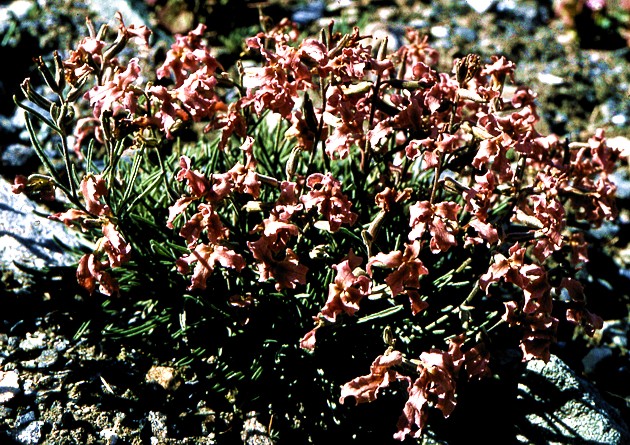
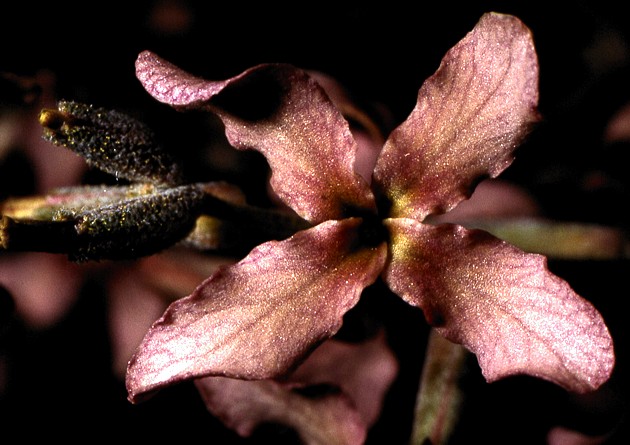
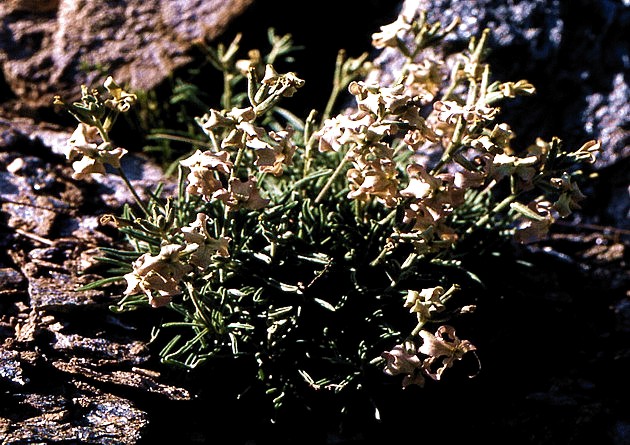
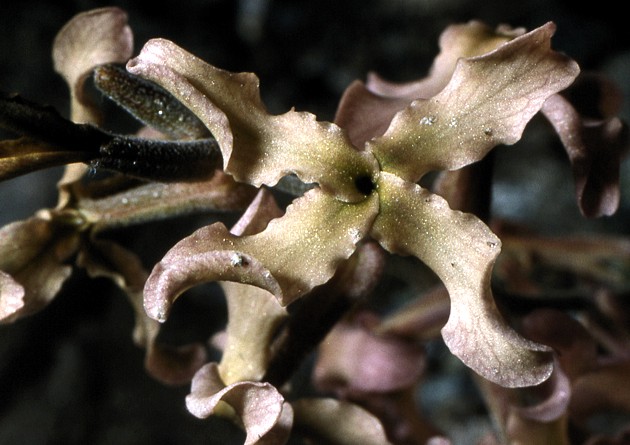
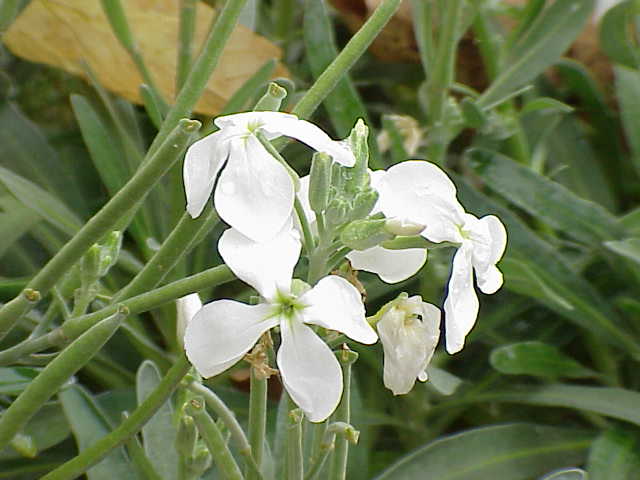
Matthiola incana - Violaciocca d'inverno
Dictionnaire
historique
de la médecine ancienne et moderne
par Nicolas François Joseph Eloy
Mons – 1778
Dictionnaire
encyclopédique
des sciences médicales
1864-1888
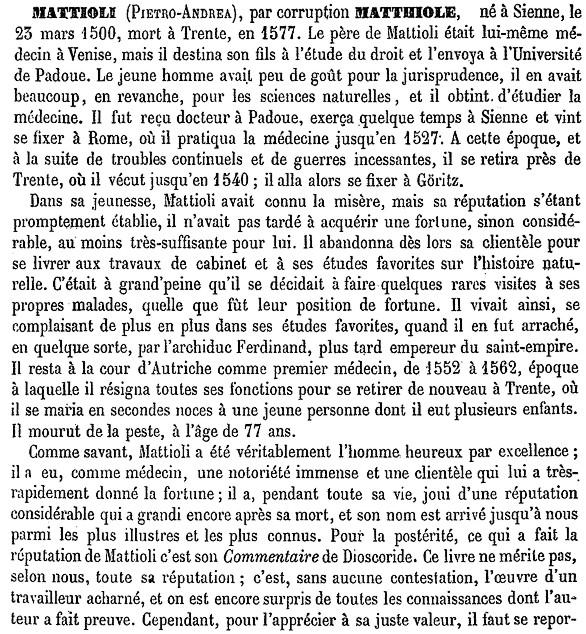
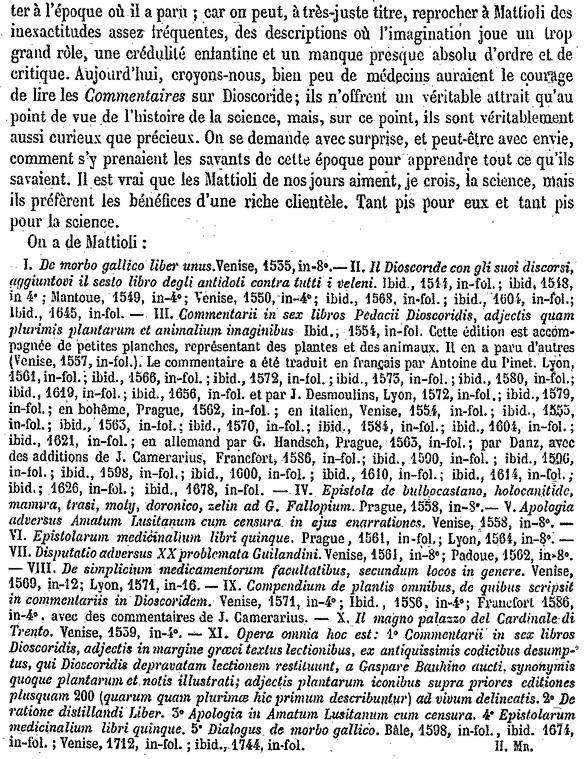
[1]
The Wellcome
Library copy of the 1544 edition cost an early owner, Pietro de Col
Agordino, 14 Venetian Lire. (Chjeck
Caius)
[2]
Note his praise of these men (inter alios) in the Prologo to the 1544 Discorsi:
il facondissimo Fraccastoro, il valentissimo Vesalio![]() primo anatomista del
mondo.
primo anatomista del
mondo.
[3] His career was short, from 1542 to 1553; see Short Title Catalogue of Books printed in Italy and of Italian Books printed in other Countries from 1465 to 1600, London, British Museum, 1958, p. 770; Short Title Catalog of Books printed in Italy and of Books in Italian printed Abroad, 1501-1600, vol. 3, Boston, G. K. Hall and Co, 1970, p. 440.
[4] It should also be remembered that the illustrations in the 1554 edition were drastically changed in later editions.
[5]
De morbis gallici curandi ratione dialogus,
Bologna, 1530; Magno palazzo del cardinale di Trento, Venice, 1539.
[6] I am aware that each edition was different from its predecessors to a greater or lesser extent, but a view of the book at three distinct and important stages emphasises the very different qualities the work took on as it progressed.
[7] Frigimelica’s commentary, Oxford, Bodleian Library, Canonici lat. misc. 31, was delivered as lectures at Padua in 1530; that of Valerius Cordus was given first at Wittenberg in 1539/40.
[8] I have consulted this in the Medici Antiqui Omnes, Venice, sons of Aldus, 1547.
[9] P. Godman, From Poliziano to Machiavelli. Florentine Humanism in the High Renaissance, Princeton, Princeton University Press, 1998, pp. 209-234.
[10] He is inferior in learning to Poliziano and to Leoniceno, for example, and in botanical knowledge to Luca Ghini; but he is also superior to the former in botany and to the latter in academic scholarship.
